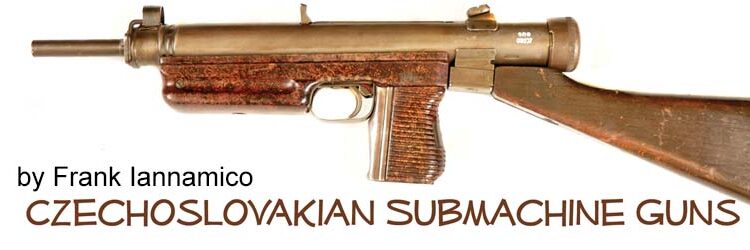By Frank Iannamico
After the end of World War II, most of the efforts in post-war Europe were being directed toward rebuilding cities, and people were primarily concerned with getting their lives back to normal. The world was finally at peace, and most countries were awash in surplus war material and weapons. Despite the peace, and many thousands of surplus small arms, weapon development in many countries continued. Most were focused toward a new class of weapon introduced during the war by Germany; the mid-range caliber Sturmgewehr made primarily of sheet metal stampings. The assault rifle was considered by many to be a weapon that would ultimately replace both the long-range battle rifle and short-range submachine gun. In spite of all the attention being focused toward the new assault rifle, a few armies still saw a place for the submachine gun in their inventory. Many new submachine gun designs emerged during World War II, and by the end of the war most of the shortcomings of World War II weapons were revealed. Designers took the best features of the World War II era submachine guns and added a few new ones.
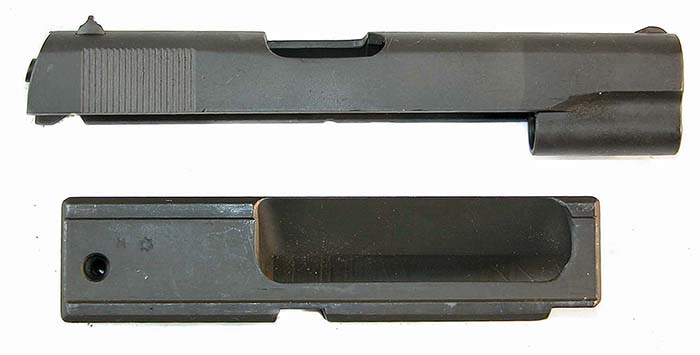
Czechoslovakia has long been an innovator in firearm designs, introducing many unique weapons. Even as a member of the Soviet led Warsaw Pact, the Czechs did not conform to the Russian standard when it came to small arms. Designs like the vz.52 pistol, vz.52/57 rifle, and vz.58 assault rifle were fielded in place of the Tokarev pistol, SKS and AK-47 rifles. The Czechs even resisted adopting the standard Com Bloc 7.62x39mm cartridges by fielding their own, more powerful 7.62x45mm round, before eventually relenting and adopting the Warsaw Pact’s 7.62x39mm cartridge. The Czech designers and engineers implemented a number of revolutionary features in their weapons, some of which were later used by other designers for their weapons.
One series of Czech submachine guns developed after the war had many innovative features, although it is not clear if they were actually the first to do so. The weapons were the 9mm Parabellum vz.23 and vz.25, and the 7.62x25mm vz.24 and vz.26; the weapons are very similar except for their caliber. The vz.25 and vz.26 had a left side-folding metal buttstock, which attached to a collar that encircled the receiver tube. The stock could be locked in an extended or folded position and when folded the sheet metal buttplate could be used as a vertical foregrip. The vz.23 and vz.24 had a fixed stock made of wood with a stamped metal buttplate. The fixed stock attached to the receiver by a bracket welded to the bottom of the receiver tube; although some early fixed stock models had the same type of 360-degree stock bracket as the folding stock version. The Czech submachine guns featured an 8.25-inch long telescoping bolt, which surrounds the 11-inch barrel for 6.25-inches, allowing the weapon to have a relatively long barrel and a short overall length. The barrel, secured to the receiver by a threaded collar, could be easily removed for cleaning or replacement. A sling attachment loop was located behind the barrel retaining collar. The magazine well was located in the pistol grip, which gave the weapon good balance – enough to fire it using one-hand, if necessary, with some reasonable accuracy. Both the 9mm and 7.62 models used an excellent double-feed, triangular shaped steel magazine. Despite having such features, the Czech weapons are rarely recognized as most accolades go to the similar Israeli Uzi submachine gun, which was developed around the same period, although the prototype of the vz.23, the vz.447 was tested in 1948, reportedly a few years before the Uzi.
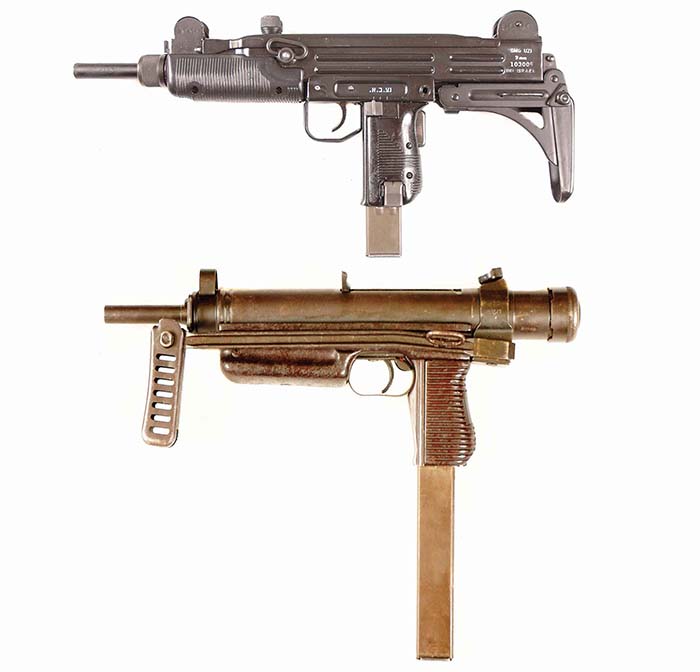
Submachine gun development in Czechoslovakia began as early as 1920, but progress was slow. The Czech army considered the U.S. Thompson and the German MP18, but after testing, rejected both weapons. During 1930s the ZK383 submachine gun was designed by the Koucky brothers at the Brno factory. The well crafted ZK383 had a bipod, a quick-change barrel, and a bolt that had a removable weight to change the full-automatic cyclic rate; features not normally found on submachine guns. The ZK383 submachine gun was sold to Bulgaria, Germany and a few countries in South America, but was not officially adopted by the Czech army. A few months prior to the start of World War II, Czechoslovakia was occupied by the German Wehrmacht. The Germans took over the Czech arms factories, putting them to work supplying their war machine.

During the post World War II era, the newly reorganized Czechoslovakian army was equipped with a variety of foreign-made small arms. While most countries stopped all development work on pistol-caliber submachine gun designs after the war Czechoslovakia, having no immediate requirement for an assault rifle, initiated a program to develop a new submachine gun. A relatively large number of indigenous designs were submitted by both the Zbrojovka Brno (ZB) and Ceska Zbrojovka (CZ) factories for test and evaluation. Since the test and evaluation program was being conducted during peacetime, there was no sense of urgency to find a suitable weapon. The first 9mm prototype submachine gun design, the ZB47, was tested in 1946, followed by the ZK 466, the H/47, CZ 47/1, CZ 147, H/P, CZ 47/P, ZK 471, CZ 447 and the CZ 247. The testing was further complicated in 1947 when it was decided that the program should include weapons firing the 7.62x25mm Soviet cartridge causing further problems and delays. As a result of the new 7.62mm round requirement, more prototypes were produced to include the CZ 248 and the ZK 476. By July of 1948 the competition was down to two finalists, the CZ 447 developed at the Strakonice plant and the ZK 476 from the Brno factory. The 9mm CZ 447 was chosen for production, after the army requested that the production weapon be chambered for the 9mm round. In 1948 the CZ 447 was adopted as the Sa vz. M48a for the fixed stock model and Sa vz. M48b for the folding stock version. Sa represents Samopal or submachine gun and vz stands for vzor or model. During 1950 the designations were changed, the M48a became the vz.23 and the M48b the vz.25.

After a relatively short period, production of the 9mm vz.23 and vz.25 submachine gun ceased on 26 May 1950. Orders were received to convert the design to fire the Soviet Pact 7.62x25mm pistol round, to conform with other Warsaw Pact members. Although a seemingly easy conversion, it was nearly a year later on 11 June 1951, when the new 7.62x25mm models were put into production. The wooden-stocked submachine gun was designated as the Model 24, and the folding stock variant the Model 26. The 9mm and 7.62 models look very similar; however, the pistol grip of the 9mm is attached to the receiver at a 90-degree angle, while the 7.62 model is canted at an 87 degree angle to the front. Other differences between the two caliber models: the 9mm barrel has six grooves, while the 7.62 barrel has four. The 9mm model used two different magazines, one with a 24-round capacity, the other held 40-rounds. There was only one magazine for the 7.62 model, which held 32-rounds. To differentiate the 7.62 magazine, it has a long vertical impression on both sides. The width of the magazine was extended approximately 5mm to accommodate the 7.62x25mm cartridge, which is approximately 4.3mm longer than a 9mm round. The 7.62 model had a slightly heavier bolt to handle the more powerful round. The 9mm models had an unloaded weight of 6.8 pounds while the 7.62mm version was slightly heavier at 7.25 pounds unloaded, largely due to its redesigned bolt.

The Czech models 23 through 26 were constructed in the same manner, primarily from sheet metal stampings; the receiver is a seamless tube. The select-fire weapons all fire from an open bolt and the cyclic rate is approximately 600 rounds per minute. A progressive trigger controls the mode of fire; pulling the trigger partially to the rear provides semiautomatic fire, while pulling the trigger completely to the rear provides the operator with a full-automatic function. The long bolt has a fixed firing pin and extractor. The recoil spring is held by a rod on the left side of a circular plate located at the back of the receiver alongside an ejector rod. The bolt has a space in the center to allow the cartridges to eject as it passes by the ejection port in the receiver. When the bolt is forward or to the rear position the ejection port is blocked by the bolt, which helps to keep debris from entering the receiver. The back of the receiver has an end cap to facilitate the removal of the bolt assembly. The cap is secured by a series of lugs on the receiver and held in place by the dimples in the cap and pressure from the recoil spring. The front sight is a blade type protected by a metal hood and the adjustable rear sight is a square shape with four positions: 100, 200, 300 and 400 meters. It is adjusted by rotating it to the desired range, which is marked under each sighting notch. On the fixed stock model, the sight is attached to a bracket spot welded onto the receiver. On the folding stock weapon the rear sight is attached to a collar welded around the receiver tube, which is used to support the folding stock. The pistol and foregrip are a composite made from phenolic resin and wood, commonly used for furniture on other Czech small arms. Located on the right foregrip is a metal insert that is used for loading the magazine. Two safeties are provided. One is located in the trigger housing; the safe position is to the right. When in the fire mode a painted red strip is visible. A second safety is the cocking handle, which can be used to lock the bolt in a forward or rearward position. Before the bolt can be retracted the handle must be pushed inward. Sling attachment loops are located behind the barrel retaining nut. The rear loop is on the side of the arm of the folding stock and on the fixed stock model the loop is attached to an inleted section of the wood. Several examples were studied and all had the manufacturer’s code “she” above the serial number on the left rear side of the receiver. Some examples had their year of manufacture below the serial number. The code “she” was that of the Ceska Zbrojovka plant in the town of Uherský Brod. Early submachine guns were blued, while many later models were phosphated or painted gray. The design of the vz.23 and vz.25 submachine guns have been credited to Vaclav Holek, assisted by F. Myska, J. Kratochvil, and V. Zibar.

M48 Ammunition
The 7.62x25mm M48 ammunition has been documented in several publications as being 20-percent “hotter” than normal loads, and often cited as being for “submachine gun use only.” The M48 ammunition has been the subject of much internet debate as to whether or not this is fact or fiction. The ammunition does generate more felt recoil and muzzle flash than most 7.62x25mm rounds, but there has been no official documentation found as to whether or not it was intended only for use in submachine guns. The ammunition comes packed on 8-round stripper clips, presumably for ease of loading in the vz.24 and vz.26 subguns. There are five clips packed in each cardboard box (40 rounds). One type has gray painted cases with the headstamp markings “aym” and a year of manufacture (usually 52 or 53). There are other types of Czech-made 7.62×25 ammunition on stripper clips that have brass cases and different head stamps.
By the early 1960s the 7.62 vz.24 and vz.26 submachine guns were being phased out and replaced by the 7.62x39mm vz.58 assault rifle: another very unique Czech design. The submachine guns were sold or given to other communist nations and were eventually distributed around the world. The weapons have surfaced in Cuba, Syria, Nigeria, Chile, Cambodia, Libya, Lebanon, and South African among others, often in the hands of terrorist groups.
To charge the magazines with the loader located on the right side of the foregrip:

- Insert the 8-round stripper into the loading slot on the foregrip, the clip is held stationary by a guide stop on the end of the slot.
- Place the edge of the magazine at the bottom of the guide slot and push the magazine toward the cartridges.
- After the cartridges are pushed into the magazine the empty stripper clip is simultaneously moved forward and ejected from the slot.
- The procedure is repeated until the magazine is filled.
Field Stripping Procedures:
- Remove the magazine and visually inspect the chamber to insure that no cartridges are present.
- Depress the button in the center of the endcap, at the same time turn the endcap to remove it from the receiver.
- Retract the cocking handle and push it down into the bolt, the bolt and recoil spring assembly can be removed through the rear of the receiver tube.
- To remove the barrel, loosen the barrel retaining nut and slide the barrel out of the receiver.
- Reverse the procedure to assemble.
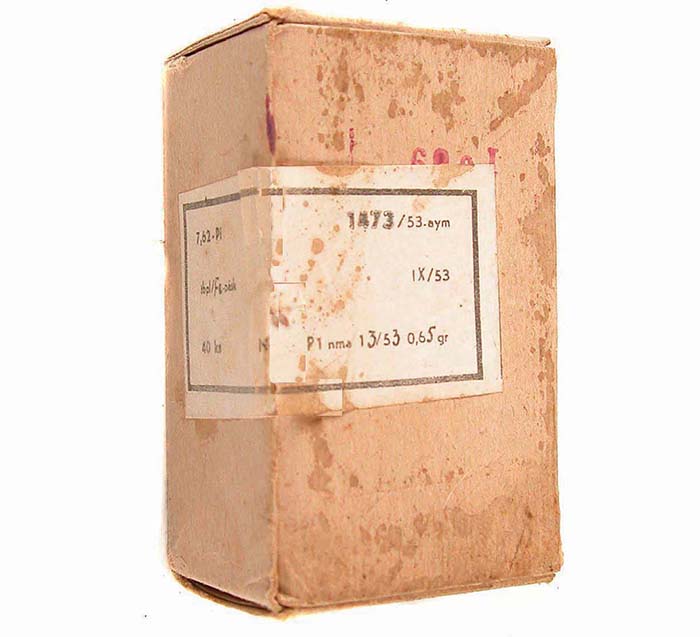
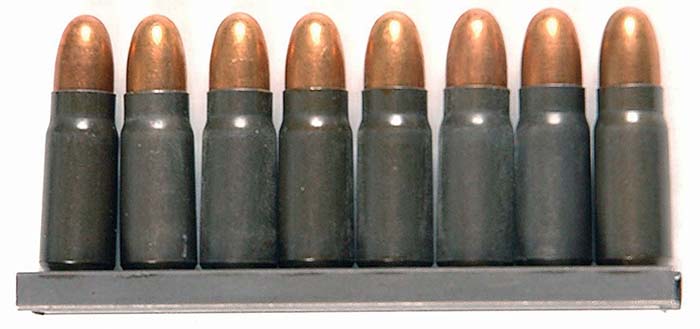
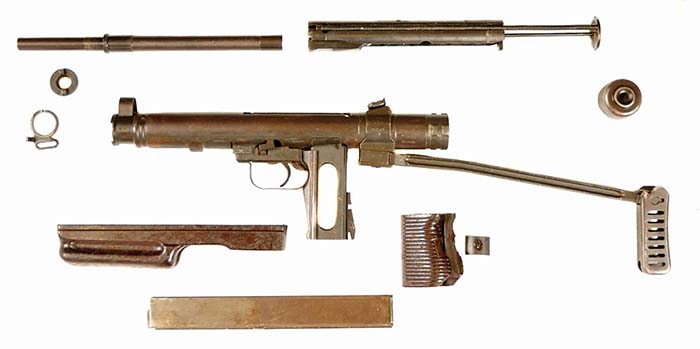
| This article first appeared in Small Arms Review V17N2 (June 2013) |



